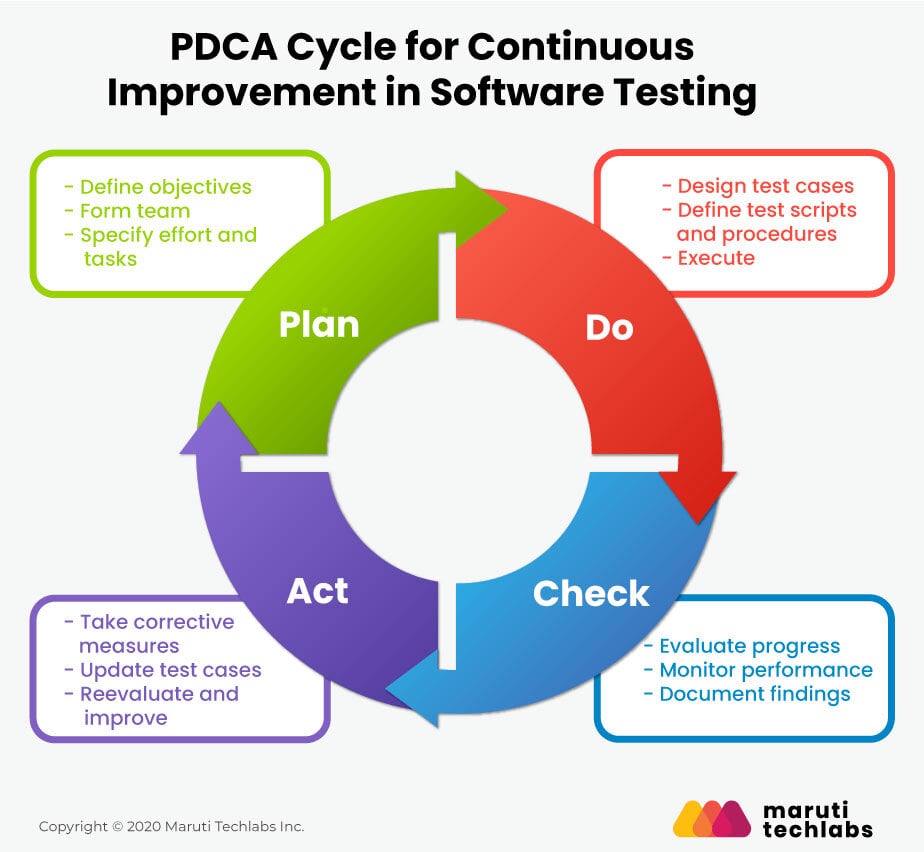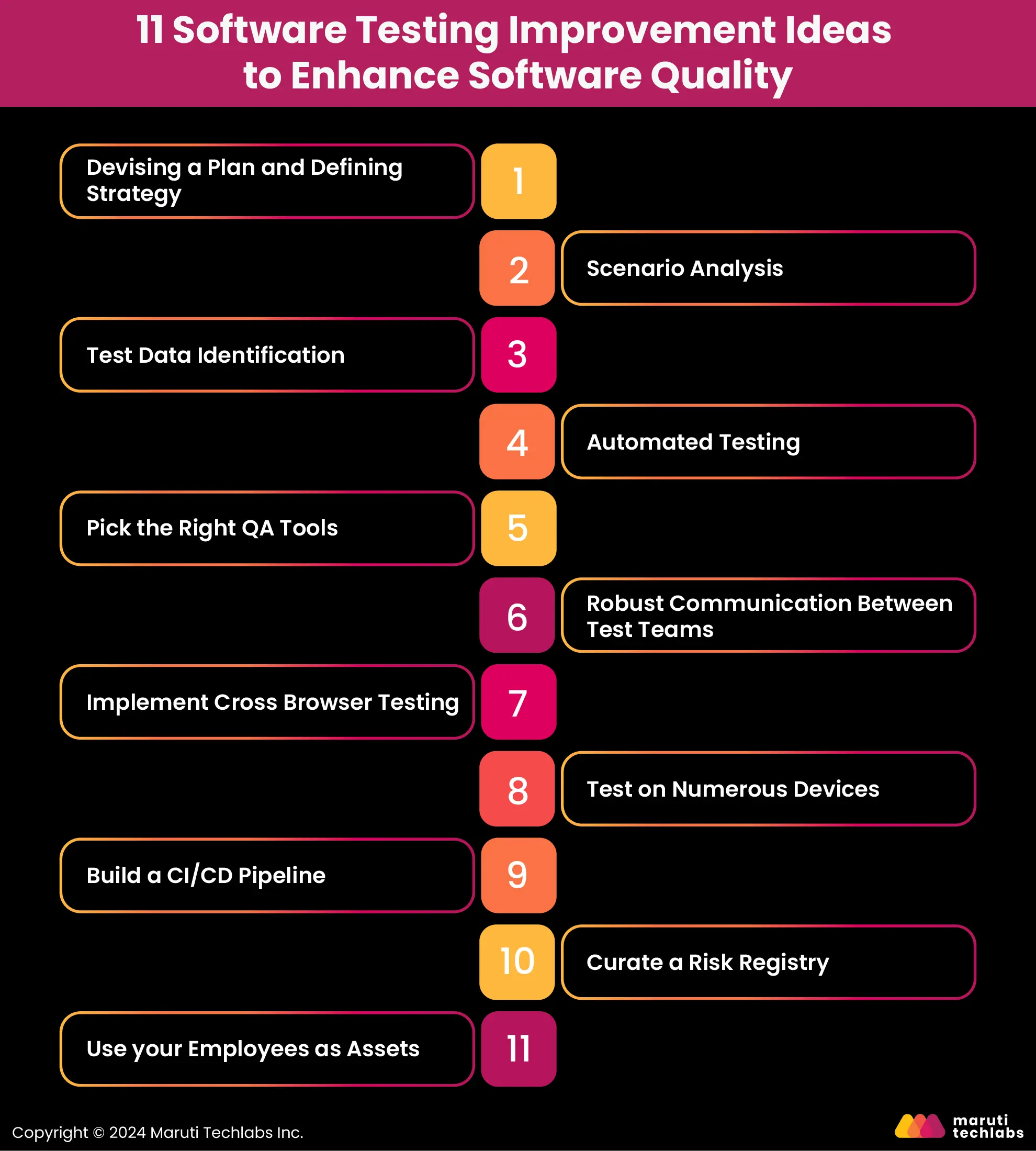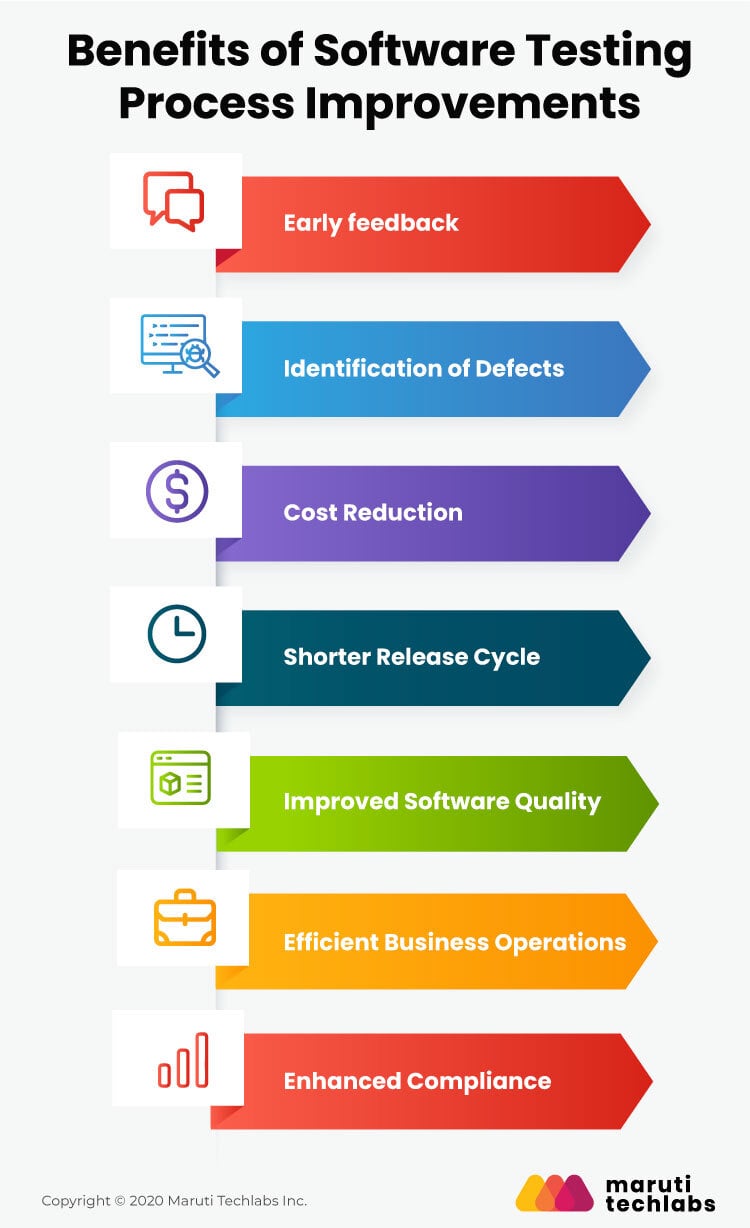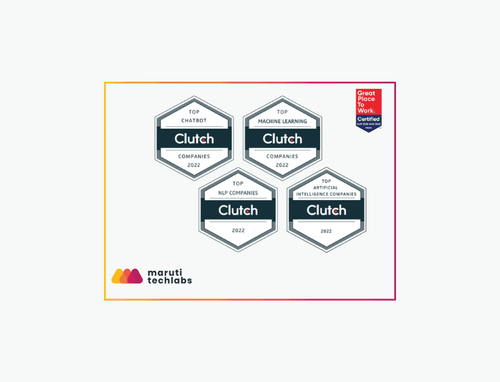

11 Innovative Software Testing Improvement Ideas






“A stitch in time saves nine”, goes the old adage. The same holds true in the case of software development life cycle. The earlier you detect and fix bugs, the more you save on costs and time. And continuous process improvement in software testing is exactly that stitch.
The best way to ensure high-quality software is to implement effective and timely QA testing best practices that offer robust tools and methodologies to build flawless products.
Software testing is the process of checking a software application to make sure it works correctly, is free of errors (bugs), and meets user needs.
In simple words: It’s like examining a product before delivering it to ensure it does what it’s supposed to do without problems.
Before launching a food delivery app, testers check if:
If issues are found, they’re fixed before users get the app.
7. Acceptance Testing (UAT)
Software life cycle testing essentially means that testing occurs parallelly with the development cycle and is a continuous process. It is important to start the software testing process early in the application lifecycle, and it should be integrated into application development itself.
To be able to do the same, there needs to be continuous effort and commitment on the part of the development organization, along with consistent communication with the quality assurance team.
Achieving this feat from the go may require external assistance from CTO consulting companies.

One of the top approaches in software testing best practices is PDCA – plan, do, check, and act – an effective control mechanism used to control, govern, supervise, regulate, and restrain a system.
Here is how the PDCA approach works in the context of continuous process improvement in software testing –
In this step of the software testing improvement process, test objectives are defined clearly, including what is to be accomplished as a result of testing. While the testing criteria ensure that the software performs as per the specifications, objectives help to ensure that all stakeholders contribute to the definition of the test criteria in order to maximize quality.
This stage in continuous process improvement in software testing describes how to design and execute the tests that are included in the test plan. The test design typically includes test procedures and scripts, test cases, expected results, test logs, and more. The more comprehensive a test plan is, the simpler the test design will be.
The Check step of the continuous improvement process primarily includes a thorough evaluation of how the testing process is progressing. At this stage, it is important to base decisions on accurate and timely data such as the workload effort, number and types of defects, and the schedule status.
The Act step of the continuous improvement process includes outlining clear measures for appropriate actions related to work that was not performed as per the plan. Once done, this analysis is used back into the plan by updating the test cases, test scripts, and reevaluating the overall process and tech details of testing.
Similar to any other business investment, quality assurance, or QA improvement ideas must bring value to the enterprise. This value expected from the quality assurance process is to make the software processes much more efficient while ensuring that the end-product meets customers’ needs.
When translated into measurable objectives such as flawless design and coding, elimination of defects early on, and ensuring efficient discovery, it can lead to better software processes and a value-driven final product.
To achieve this objective, businesses need to improve their processes to install quality assurance activities at every stage of the software life cycle.

Here are some of the software testing best practices that can help you achieve your goal of smarter and effective testing-
Effective planning entails the creation of quality management and test plans for a project. Before you start investing time, resources, and money into the project, it’s recommended to check whether the plan has covered all the basics and is feasible in terms of timeline and resources.
Quality management plan – defines a clear and acceptable level of product quality and describes how the project will achieve the said level. The main components of a quality management plan are –
Test strategy – The outline of a good strategy includes a detailed introduction, the overall plan, and testing requirements.
The main components of a test strategy include –
Irrespective of how comprehensive a test plan is, problems are inevitable, which would escape from one test phase to the next. Post-project & in-process escape analysis, therefore, is critical for driving the test improvements.
While there can be instances where the testing team is required to directly start test execution, it is always better to create a high-level scenario during the early stages of requirement study and ensure that it is reviewed on a consistent basis.
There are multiple benefits that this kind of reviews can bring including –
When we design test scenarios or test cases, we create various types of tests, including negative and positive cases. To be able to execute the planned tests, we require different types of data that need testing using simple parameters. But, there are several instances where the same data needs to be generated from a different source and requires transformation before it reaches the destination system or flows into multiple systems.
It is, therefore, always a great practice to start with identifying the data sets early on during the test design phase instead of waiting until the test execution phase starts.
At this stage, you need to look for the answers to some of the important questions such as –
Continuous testing and process improvement typically follows the test early and test often approach. Automated testing is a great idea to get quick feedback on application quality.
It is, however, important to keep in mind that identifying the scope of test automation doesn’t always have to be a different exercise and can easily be identified during the manual test execution cycle by identifying the most painful areas and determining how those can be automated.
Some of the points to take care of during automated testing include –
It is important for testers to pick the right testing tools based on the testing requirement and purpose. Some of the most widely used tools are Jenkins, Selenium, GitHub, New Relic, etc.
Best QA improvement ideas mainly include planning the entire procedure for QA automated testing, picking up the right tools, integrating QA with other functions, creating a robust testing work environment, and performing continuous testing.
Continuous improvement is always a byproduct of continuous communication. In software testing best practices particularly, it is a great strategy to consider frequent communication between teams whose activities overlap during an active product development cycle. This helps to ensure that they are actively communicating observations, concerns, & solutions to one another.
A nightmare for developers is ensuring software runs seamlessly across different mobile phones and browsers with varying screen sizes. With the continual innovation of new models and devices, cross-browser testing has become ever-important. Developers can craft the perfect user experience by leveraging cloud-based cross-browser testing.
Besides being cost-effective, cross-browser testing enhances the speed and performance of your products while presenting a scalable and dynamic test environment.
Multi-device testing can strengthen software development and quality enhancement processes. Testing as many variations as possible is imperative to offer a consistent user experience across different devices with changing operating systems and screen sizes.
CI/CD, short for Continuous Integration and Continuous Delivery, is a tested development approach that facilitates smooth software updates and deployment. Here’s how this methodology can work for you.
If you imagine software as a puzzle, a developer can add chunks of coded pieces to the central puzzle board using CI. This makes the codebase more stable and reliable and helps catch errors at an early stage.
Once all the puzzle pieces are in place, CD can help deliver them to users. This facilitates faster deployment, feedback, and iterations, allowing frequent changes.
CI/CD can be viewed as a well-oiled assembly line for software. CI ensures all pieces tether seamlessly, while CD fastens the delivery to the customer.
Project managers are aware that risk monitoring is crucial to quality software development. Also known as a risk log, a risk registry is curated to learn, track, and analyze potential risks. To mitigate these risks effectively, all team members should create a risk registry that monitors, assesses, and assigns priority to corresponding risks.
A risk log may include the following:
A risk log may contain the following categories:
Your employees can be familiar with the latest trends, technologies, and techniques in software development. Training your employees well can help them observe the role of end-users sharing valuable insights with leading software products. Subsequently, your team can learn flaws and limitations before deployment with user experience that may be missed otherwise.
An increasing number of organizations are realizing the fact that improving the test process is critical for ensuring the quality of the software and overall business processes and multiple other benefits it offers. Some of these are listed below –

Deployment of continuous testing ensures early feedback to the development team about various types of issues the code may cause to existing features.
Further test process improvement provides frequent, actionable feedback at multiple development stages to expedite the release of software applications into production with a much lesser number of defects. Another benefit of this early feedback is in analyzing business risk coverage to achieve a faster time to market.
The process of test process improvement plays a crucial role in ensuring error-free outputs. Continuous testing ensures a quicker turnaround time when it comes to the identification and elimination of the expected code errors early in the development lifecycle. The result is a substantial reduction in the overall cost of resolving defects.
Test process improvement and automated testing equip organizations to better respond to frequent market changes. With continuous testing and test automation, organizations also get the advantage of quickly developed and frequently released updates.
Automated testing allows testing of the developed code (existing & new) rigorously and constantly. It also focuses on rapid error resolution to ensure clean code delivery and better integrations to speed up the launch of the application on a regular basis.
Among some of the other advantages of test process improvement include –
The continuous process improvement in software testing not only ensures higher product quality but also optimizes business processes. However, in practice, it is often quite challenging to define the steps needed to implement QA improvement ideas.
Organizations must reinvent their software testing processes in today's dynamic market to remain competitive by incorporating quality engineering and assurance services. The need is to have a well-defined standard for testing or a continuous improvement program that is constantly evolving to meet both the customers’ and the organization’s business needs.
Get in touch with us to receive end-to-end services with outsourcing mobile app testing. Our collaborative and methodical approach can help you reduce testing time, run timely test cycles, elevate your product quality, and save resources.
Having a robust quality assurance process in place for all stages of the software life cycle is the key to efficient systems, significant savings, and a much higher ROI.
If you’re looking for a software development company in Chicago that understands the value of innovative QA strategies, Maruti Techlabs is your trusted partner. Let us help you streamline your testing processes and deliver consistently high-quality software.
Automated testing allows teams to conduct more tests in less time by automating repetitive tests. This facilitates quicker feedback, allowing programmers to learn and rectify issues promptly.
Here are a few practices you can follow to ensure your testing strategy is compatible with your development methodology.
3. What are the best practices for prioritizing test cases based on risk assessment?
Prioritizing test cases based on risk assessments ensures vital aspects of the software are tested first. Here are a few pointers to keep in mind to minimize potential risks.
When determining which test cases to automate or conduct manually, you must evaluate individual cases based on complexity, stability, frequency, and risks.
Here are some of the top test data management techniques.
Here are the best practices you can leverage to implement continuous testing.


